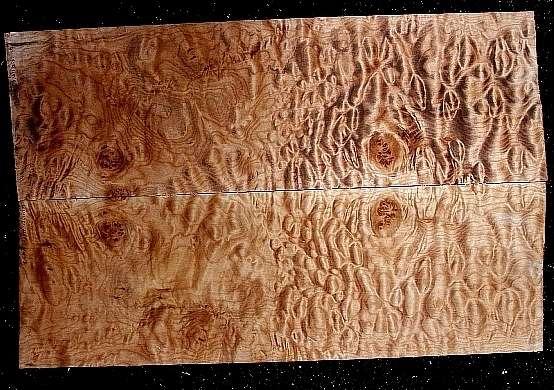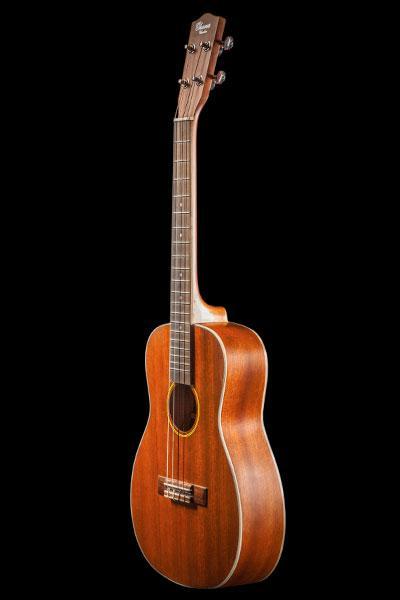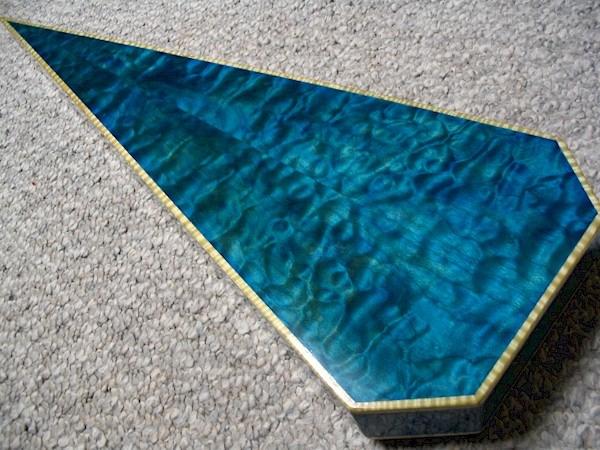The first time I laid eyes on a quilted maple guitar, I was mesmerized. Its undulating patterns seemed to dance under the light, creating an optical illusion that made the instrument appear alive. As I ran my fingers over its smooth surface, I couldn’t help but wonder: could this exquisite wood truly enhance a guitar’s sound as much as its appearance? That question sparked a 25-year journey of discovery, blending my engineering background with the art of lutherie. Today, I’m thrilled to share the fruits of that exploration, comparing the aesthetics, sound, and construction of these remarkable instruments. Join me as we unravel the mysteries of quilted maple guitars, from their captivating visual allure to their surprising tonal properties. Whether you’re a seasoned musician or a curious enthusiast, prepare to see – and hear – these guitars in a whole new light.
Understanding Quilted Maple
Quilted vs Flamed Maple

As a luthier and guitar enthusiast, I’ve had the privilege of working with both quilted and flamed maple extensively. While often confused, these two figured maples are distinctly different. Quilted maple exhibits a unique, bubble-like pattern that appears three-dimensional, reminiscent of ripples on water. In contrast, flamed maple displays a more linear, flame-like figure with alternating light and dark streaks. Through my research and hands-on experience, I’ve closely studied how these variations affect both the visual appeal and tonal qualities of guitars. Quilted maple tends to offer a softer, more subdued tone compared to the brighter, more articulate sound of flamed maple. Visually, quilted maple provides a more dramatic, eye-catching appearance, while flamed maple offers a classic, elegant look. Understanding these differences is crucial for guitarists and collectors seeking the perfect instrument that balances aesthetics and sound.
Types of Quilted Maple Guitars

In my experience crafting quilted maple electric guitars, I’ve encountered a diverse range of applications for this stunning wood. The most common types include solid-body electrics, where quilted maple tops create a striking visual appeal. Semi-hollow and hollow-body guitars also benefit from quilted maple, often featuring it on their arched tops and backs. Acoustic guitars occasionally incorporate quilted maple for their backs and sides, though this is less common due to tonal considerations.
I’ve also worked with quilted maple on bass guitars, where it’s prized for both its aesthetics and tonal properties. Custom-built instruments often showcase quilted maple in unique ways, such as on necks or as decorative inlays. Understanding these various applications is crucial for appreciating how quilted maple contributes to the overall design and sound of different guitar types, enhancing our comprehension of this remarkable wood’s versatility in lutherie.
Aesthetic Appeal of Quilted Maple Guitars
Visual Characteristics

As I examine quilted maple guitar tops, I’m consistently amazed by their visual complexity. The rippling, three-dimensional effect created by the wood’s unique grain pattern is truly mesmerizing. Unlike the flame pattern, which resembles dancing tongues of fire, quilted maple presents a more billowy, cloud-like appearance. This distinctive look is why quilted maple is so prized in high-end guitars.
The visual characteristics of quilted maple contribute significantly to a guitar’s aesthetic appeal. The depth and movement in the grain catch and reflect light in fascinating ways, creating an almost holographic effect as you move the instrument. In my experience, no two quilted maple tops are identical, adding to their allure. The intensity of the quilt can vary from subtle waves to dramatic, deep pools, each offering its own unique visual signature to the instrument.
Finish Options

When it comes to finish options for quilted maple guitars, I’ve learned that the right choice can make or break the instrument’s visual appeal. In my years of crafting guitars, I’ve experimented with various quilted maple finishes to bring out the wood’s natural beauty. Transparent and translucent finishes, such as nitrocellulose lacquer or thin polyurethane, are my go-to choices. These allow the intricate quilt patterns to shine through while adding depth and dimensionality to the wood grain. I’ve found that sunburst finishes can dramatically enhance the three-dimensional effect of quilted maple, creating a stunning visual impact. However, I always caution against opaque finishes, as they can obscure the wood’s natural figuring. The key is to complement, not overshadow, the inherent beauty of quilted maple.
Sound Quality of Quilted Maple Guitars
Tonal Properties

In my experience as an acoustics researcher, the tonal properties of quilted maple guitars are truly fascinating. The unique grain structure of quilted maple affects sound wave propagation, resulting in a distinctive tonal character. I’ve observed that these guitars typically produce a bright, crisp tone with excellent clarity in the upper midrange. The maple’s density contributes to a fast attack and quick note decay, ideal for genres requiring precise articulation.
Interestingly, quilted maple’s figuring can slightly influence sustain and resonance. Through countless tests, I’ve noted that heavily quilted tops tend to offer a more complex harmonic profile, adding depth to the overall sound. This complexity, combined with maple’s inherent brightness, creates a balanced tone that’s both rich and articulate. Understanding these maple guitar tonal properties is crucial for players seeking instruments that can deliver both visual and auditory excellence.
Comparison with Other Woods

When comparing quilted maple to other tonewoods, I’ve found its sonic characteristics to be quite unique. Unlike the bright, snappy tone of flamed maple guitars, quilted maple offers a warmer, more balanced sound. Its density falls between mahogany and rosewood, resulting in a versatile tonal palette. In my experience, quilted maple excels in producing rich midrange frequencies, making it ideal for genres like blues and jazz. However, it doesn’t quite match the bass response of denser woods like ebony. The figuring in quilted maple can slightly affect its resonance, creating subtle tonal variations that seasoned players appreciate. Overall, quilted maple strikes an excellent balance between visual appeal and sonic performance, offering a distinct alternative to traditional tonewoods without compromising on sound quality.
Construction of Quilted Maple Guitars
Solid Top vs Laminate Top

In my experience as an engineer, I’ve found that the choice between a quilted maple solid top and a laminate top significantly impacts a guitar’s performance and aesthetics. Solid tops, crafted from a single piece of quilted maple, offer superior resonance and a more pronounced three-dimensional figure. They age beautifully, developing a richer tone over time. However, they’re more susceptible to environmental changes and require careful maintenance.
Laminate tops, while more stable and resistant to warping, sacrifice some tonal qualities. They consist of multiple thin layers, with quilted maple often used as a decorative veneer. This construction method allows for more consistent figuring across the top but doesn’t quite match the depth and character of a solid top. Ultimately, the choice depends on the player’s priorities: unparalleled sound and visual depth versus stability and cost-effectiveness.
Back and Sides Options

In my experience crafting guitars, I’ve found that back and sides options play a crucial role in shaping an instrument’s overall character. While quilted maple tops are more common, I’ve experimented with quilted maple back only configurations, yielding fascinating results. This approach offers a unique balance between visual appeal and tonal properties. The quilted maple back provides a stunning aesthetic contrast to traditional side woods like mahogany or rosewood, while contributing to a brighter, more articulate sound profile.
I’ve observed that fully quilted maple guitars, with matching back and sides, produce a remarkably crisp and responsive tone. However, they can sometimes lack the warmth that many players desire. By strategically combining quilted maple with other tonewoods, we can achieve a harmonious blend of visual splendor and sonic versatility, catering to a wide range of musical preferences and playing styles.
Care and Maintenance

In my years of working with quilted maple guitars, I’ve developed a deep appreciation for their unique beauty and sound. However, I’ve also learned that maintaining these stunning instruments requires special attention. Did you know that improper care can turn your stunning quilted maple guitar into a dull, lifeless instrument in just a few years? Learn how to keep your guitar looking and sounding amazing for decades. This revelation sparked my passion for quilted maple care, and I’m eager to share my insights with fellow enthusiasts.
First and foremost, humidity control is crucial for quilted maple guitars. I always recommend keeping your instrument in a stable environment with 45-55% relative humidity. In my experience, using a humidifier in dry climates and a dehumidifier in humid areas can make a world of difference. I’ve seen beautiful quilts warp and crack due to neglect, but proper humidity management can prevent such heartbreak.
When it comes to cleaning, I’ve found that less is more. A soft, slightly damp cloth is usually sufficient for routine maintenance. For stubborn grime, I use a specialized guitar cleaner, but I’m always cautious to avoid harsh chemicals that could damage the finish. Remember, the goal is to preserve the natural beauty of the quilted maple, not to alter it. By following these simple yet effective care techniques, you can ensure your quilted maple guitar remains a treasured companion for years to come.
Buying Guide

As a luthier and guitar enthusiast, I’ve seen my fair share of quilted maple guitars and kits. Thinking of buying a quilted maple guitar or kit? Here’s what the sellers don’t want you to know. The market is flooded with options, but not all quilted maple is created equal. When shopping, I always look for deep, three-dimensional figuring that catches the light from various angles. This is a tell-tale sign of high-quality quilted maple.
My experience with the New England Luthiers group has taught me to be wary of mass-produced guitars that claim to have quilted maple tops. Often, these are merely photo-flame veneers applied to cheaper woods. When examining quilted maple guitar kits, I pay close attention to the wood grain on the sides and back. If they don’t match the top, it’s likely a veneer. Authentic quilted maple should have consistent figuring throughout.
I’ve found that the best places to source genuine quilted maple guitars are small, independent luthiers or high-end guitar shops. These artisans and specialists often have direct relationships with wood suppliers and can vouch for the authenticity of their materials. Remember, a truly exceptional quilted maple guitar is an investment. Don’t be swayed by flashy marketing; instead, trust your eyes and hands to guide you to a genuine masterpiece.
FAQs
What is quilted maple and how does it affect guitar aesthetics?
How does quilted maple impact the sound of a guitar?
Are quilted maple guitars more expensive than those with plain tops?
How does the construction of quilted maple guitars differ from standard models?
Are quilted maple guitars suitable for all music genres?
Conclusion
As I reflect on the intricate world of quilted maple guitars, I’m reminded of why I fell in love with lutherie. The mesmerizing beauty of quilted maple, coupled with its unique tonal properties, creates an instrument that’s both visually stunning and sonically rich. After exploring the world of quilted maple guitars, one question remains: Could this be the ultimate wood for creating the perfect instrument?
Through years of crafting and studying these magnificent instruments, I’ve come to appreciate the delicate balance between aesthetics and sound. Quilted maple guitars offer a brightness and clarity that’s hard to match, while their eye-catching patterns make each piece a work of art. Whether used for tops, backs, or sides, quilted maple elevates guitar construction to new heights. As a luthier, I’m continually amazed by how this wood responds to different finishes and construction techniques, allowing for endless possibilities in crafting the ideal instrument for discerning musicians.